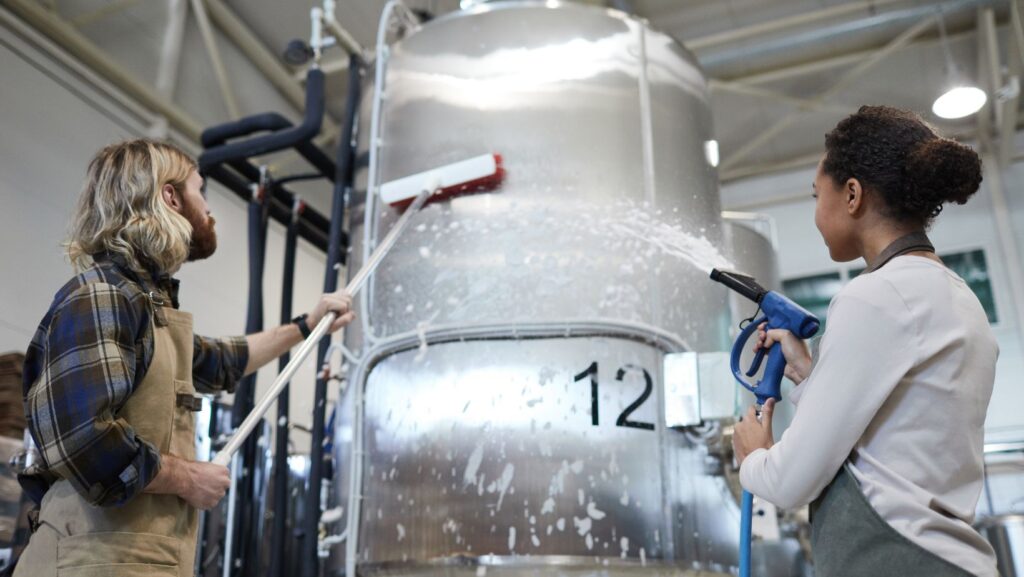
Clean-in-Place (CIP) systems play a crucial role in maintaining hygiene standards across various industries, particularly in food and beverage production. These automated cleaning processes ensure the thorough sanitization of equipment without disassembly, enhancing efficiency and consistency. Proper handling of chemicals for cip cleaning is essential to protect workers’ safety and maintain product quality.
Safety protocols for CIP chemical handling are paramount to prevent accidents and ensure a secure working environment. Workers must receive comprehensive training on equipment operation, chemical handling, and emergency procedures. Personal protective equipment (PPE) usage is mandatory when working with CIP systems to minimize exposure risks.
Implementing best practices for CIP chemical management involves proper storage, labeling, and disposal of cleaning agents. Regular maintenance of CIP equipment and accurate record-keeping of cleaning processes contribute to optimal system performance and compliance with industry standards.
Key Takeaways
- Proper training and PPE usage are essential for safe CIP chemical handling
- Regular maintenance and record-keeping optimize CIP system performance
- Correct storage and disposal of cleaning agents ensure workplace safety
Understanding CIP and Its Importance in the Industry
Clean-in-place (CIP) systems are crucial for maintaining hygiene standards and operational efficiency in various industries. These automated cleaning processes ensure thorough sanitation of equipment without disassembly.
The Basics of CIP Systems
CIP systems use a combination of cleaning solutions, temperature, and mechanical force to clean the interior surfaces of pipes, tanks, and processing equipment. The process typically involves pre-rinse, detergent circulation, intermediate rinse, and final sanitization steps.
CIP cycles are designed to remove product residues, prevent cross-contamination, and eliminate microbial growth. This automated approach reduces manual labor and ensures consistent cleaning results.

Key components of CIP systems include storage tanks for cleaning solutions, pumps, valves, spray devices, and heat exchangers. The system’s design considers factors like flow rates, cleaning agent concentration, and contact time to optimize cleaning effectiveness.
Significance of Effective Cleaning Processes
Effective CIP processes are essential for maintaining product quality and safety in food and beverage production, dairy processing, and pharmaceutical manufacturing. These industries rely on CIP to meet strict regulatory standards and prevent contamination risks.
CIP enhances operational efficiency by reducing downtime between production runs. It allows for quick turnaround times and increases overall equipment effectiveness.
Environmental sustainability is another important aspect of modern CIP systems. They optimize water usage, reduce chemical consumption, and minimize energy requirements compared to manual cleaning methods.
CIP also improves worker safety by limiting exposure to harsh cleaning chemicals and eliminating the need for confined space entry during cleaning operations.
Safety Protocols and Ideal Practices for CIP Chemical Handling
Proper handling of CIP cleaning chemicals is crucial for worker safety and effective sanitation. Following established protocols helps minimize risks and ensures consistent, efficient cleaning processes.
Preparation and Pre-Rinse Procedures
Before beginning the CIP process, conduct a thorough inspection of the system. Check for any leaks, damaged seals, or loose connections. Ensure all equipment is properly connected and functioning.
Perform a pre-rinse cycle with water to remove loose debris. This step improves the effectiveness of subsequent cleaning stages and reduces chemical usage.
Verify that drainage systems are clear and operational to prevent chemical backups or overflows. Install appropriate safety barriers and signage to restrict access to the cleaning area.
Concentration and Usage of Cleaning Chemicals
Accurate measurement and dilution of cleaning agents is essential for safety and efficacy. Use calibrated dosing equipment to achieve proper chemical concentrations.
Follow manufacturer guidelines for recommended concentrations of detergents, sanitizers, and disinfectants. Typically, caustic solutions range from 0.5-2% concentration, while acid washes maybe 0.5-1%.

Monitor and adjust chemical levels throughout the cleaning cycle. Automated CIP systems can help maintain consistent concentrations and reduce human error.
Ensuring Safety and Minimizing Risks
Provide comprehensive training on chemical handling, personal protective equipment (PPE) usage, and emergency procedures. Ensure workers wear appropriate PPE, including chemical-resistant gloves, goggles, and protective clothing.
Install emergency eyewash stations and safety showers near CIP areas. Regularly test and maintain these safety features.
Implement proper chemical storage practices. Store incompatible chemicals separately and use secondary containment to prevent spills.
Develop and regularly review standard operating procedures (SOPs) for CIP processes. Include steps for chemical handling, equipment operation, and emergency response.
Conclusion
Proper handling of CIP cleaning chemicals is crucial for workplace safety. Following essential tips like wearing protective equipment, ensuring proper ventilation, and understanding chemical properties can prevent accidents and injuries. Regular training and adherence to safety protocols are key to maintaining a secure work environment. By prioritizing safety measures, facilities can effectively clean equipment while protecting personnel and maintaining compliance with industry standards.










